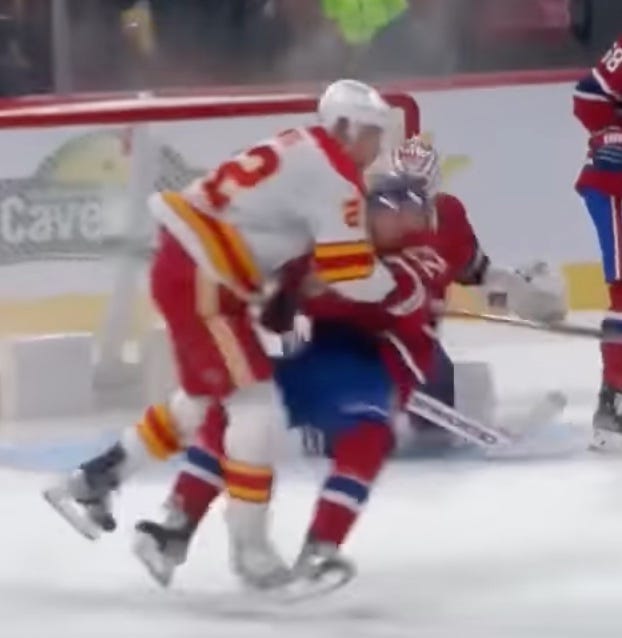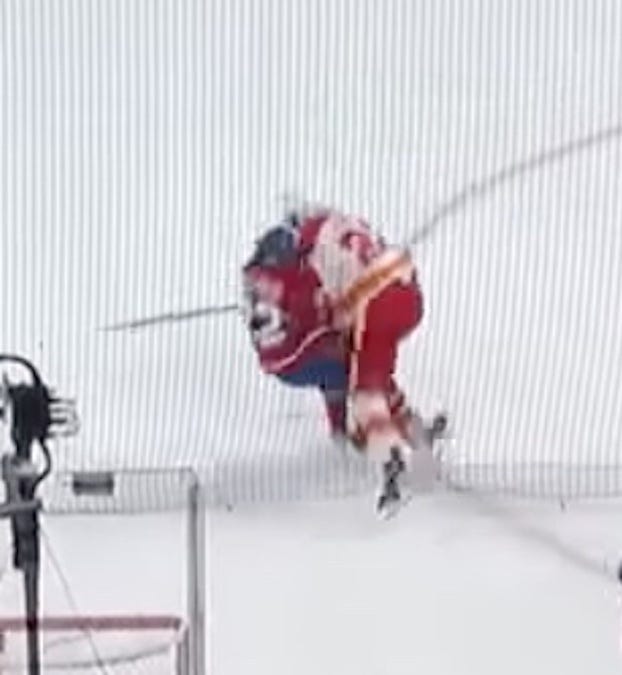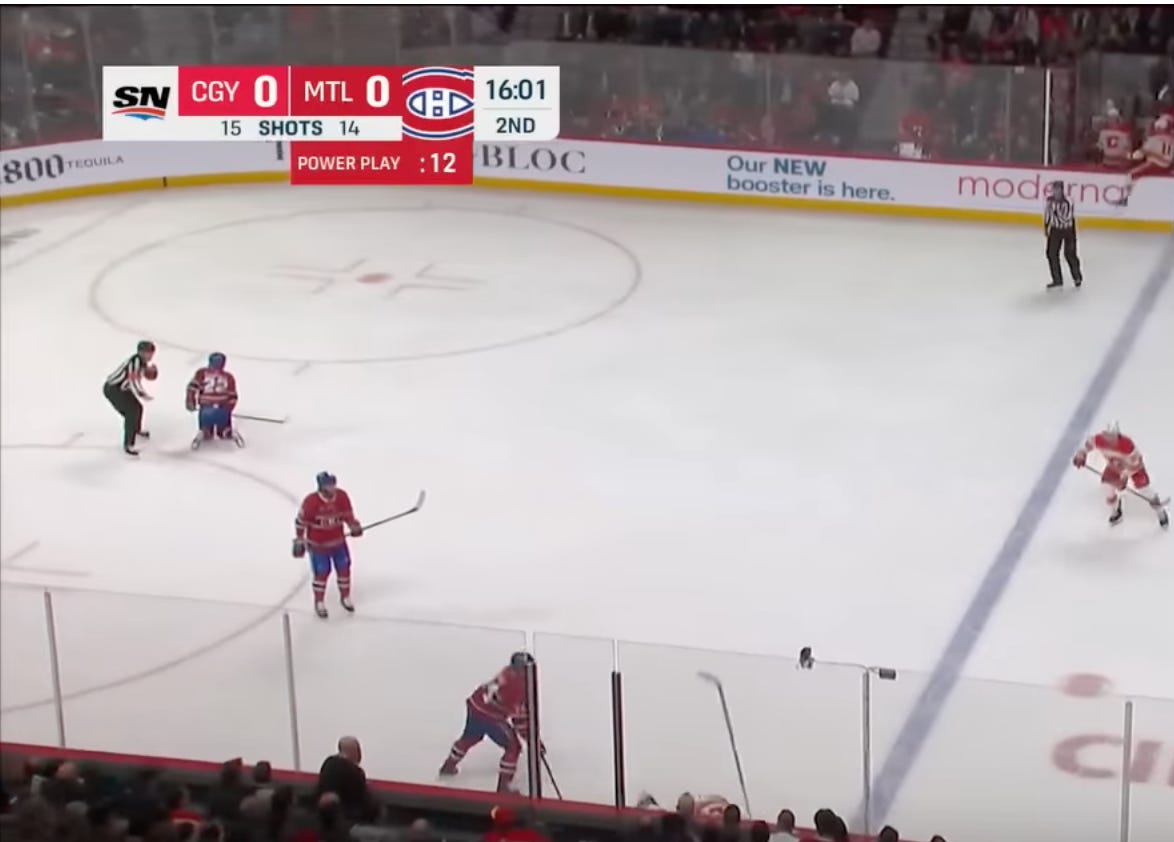Influencers & Apoplexy in the Habsphere
Everyone wants to be an influencer today but who is actually being influenced, what gives with the Habs' medical/training staff, and thoughts on goalies
Influencers
I noticed working out in the gym last week a woman carrying around a tall smart phone stand. I asked one of the trainers what was the deal with the phone stand. He explained that she was a fitness influencer, but he wasn’t sure who she was influencing. It seems today that influencers are everywhere.
The Next Big Thing
The world we live in is the democratization of mass influence. You never know when something is going to become a thing just because it goes viral on the right social media platform. Consider the latest offering by MSCHF, the Brooklyn-art collective. It is the Astro Boy inspired Big Red Boot.
A sneakerhead mentioned it to me and I noticed within a day or so, The Big Red Boot was generating media coverage in the New York Times, Wall Street Journal, and CNN among others. The boots were released on February 16th and we’ll see how many are spotted around town. I took a quick peek on Twitter and there were more than a few unboxing videos.
Old Favorites
Given the media coverage, it should not be a surprise. Thinking about people rushing out to buy them suggests two popular phrases: "sheeple" and "lemmings." I find the words amusing because of the belief that they are a recent phenomenon, but they are older expressions.
W.R. Anderson first mentioned sheeple in a 1945 commentary about proposed post-war changes to the BBC and people who mindlessly obey their government in The Music Times. He wrote, "The simple truth is that you can get away with anything, in government. That covers almost all the evils of the time. Once in, nobody, apparently, can turn you out. The People, as ever (I spell it ‘Sheeple’), will stand anything."
Alaska Fish & Wildlife News explains the lemmings' mass suicide concept came from the 1958 Walt Disney "True Life Adventure" films, which featured a segment on lemmings. A 1983 CBC investigation discovered the scenes were fake. The filmmakers bought lemmings and staged the whole thing. A few dozen lemmings were filmed running on a snow-covered lazy Susan style turntable using careful editing and tight camera angles for the migration scene. While the dramatic jumping into the ocean during the mass suicides was actually the filmmakers throwing the lemmings off the cliff.
Influencing Physical Symptoms
Unsurprisingly, the next obvious leap with all this influencing is mass psychogenic illness. That is when a group of people start feeling sick at the same time, even though there is no physical or environmental reason for them to be sick. Most notable is the outbreak of Tourette’s syndrome, whose only identifiable link was social media. The phenomenon was first identified by Dr. Kirsten R Müller-Vahl , a German Professor of Psychiatry, who published a study on it in September 2021 and was subsequently picked up by the media.
OK, But How Does This Relate To The Habs?
The Habsphere is filled with its own universe of influencers driving reactions from fans that, at times, are herdlike and could be argued to be like the old, inaccurate definition of lemmings and their fake penchant for mass suicide. However, there is a concerning trend among the team's medical and training personnel, which may be causing its own mass psychogenic event in the Habsphere.
The Last Vestiges of Bluto?
One of the hallmarks of the latter part of Bluto’s regime was the overplaying of key players on pretty marginal teams. This was how, in the four seasons after the lost 2015-16 seasons due to his knee injury, he played 62, 49, 66, and 58 games, wearing him down to the point that his career is now on a LTIR countdown. It is also when Shea Weber played 25 games with a fractured foot, causing ligament damage that hastened the end of his career. He's also on the LTIR countdown, and his contract has now been traded twice. Sean Monahan is part of that line where he was clearly injured, continued to play, and now the best-case scenario for this season’s trade deadline is a contingent transaction. At least the Habs acquired a first round pick as compensation to take him on.
When Geoff Molson announced the hiring of Jeff Gorton, one priority he talked about was a focus on player wellness. One wonders if the revamping of the organization missed the medical and training teams.
If you are the more optimistic type, one benefit of the injuries to the veterans is that the team has been able to evaluate younger players, such as Rafael Harvey-Pinard and Jus, which it would not have been able to do otherwise.
L’Affaire Caufield or Shouldergate?
Consider the near mass hysteria event that occurred in reaction to the announcement of Cole Caufield’s injury. The news came out of nowhere. It was a shock. Caufield eventually told the media that he dislocated his shoulder twice. He said it first happened on December 23rd when he fell in a game against Dallas. He then claimed he fell again in the January 3rd game against Nashville. Caufield said that after the first incident, he was able to pop the shoulder back into place and it wasn’t that big of a deal.
“Let’s Go To The Videotape”
There is more to the story. There is only one time this season Caufield was unable to finish a game and play less than 16 minutes. It was December 12th game against Calgary. He had only 8 shifts and played for 8:05 minutes.
Trevor Lewis rocked Caufield in the second period. It was a big enough hit that Sportsnet posted a video of it. Looking at the hit Zapruder-like, you can see the impact on Caufield’s right shoulder.


After the hit, Caufield did not pop up. He stayed on the ice long enough that the referee’s and linesman’s focus was on him instead of the play. The referee skated over to check on him as the puck was about to leave the zone. This was Caufield’s last shift of the game.

The next day, the team said Caufield left the game because of an "upper-body" injury. It was therefore surprising to see him back in the lineup on December 14th against Ottawa. He played 20 shifts over 19 minutes and after that he played 17 more games scoring 10 goals before being shut down.
I spoke to a friend who works with professional athletes and is on the medical/training staff of an NFL franchise. He said some shoulder injuries are hard to spot because of the muscles packed around the joint. He mentioned reading about overhead elite athletes who discovered theoretical shoulder injuries when they participated in an MRI study but were never actually injured. The check may have jarred loose something that was waiting to happen.
A Worrying Trend
But Caufield’s injury management is not an isolated incident. This season has been filled with mysterious illnesses and injuries that linger. For the second consecutive season, the Canadiens are on pace to finish with the most man-games lost. A one off now looks like the start of a trend.
There is no point is delving into the mystery of Sean Monahan's injury. Instead, consider Brendan Gallagher. On November 29th, he played against San Jose. The team announced on the 30th that he did not practice. On December 5th, the team disclosed that he was going to be out for at least two weeks with a lower-body injury. Gallagher then returned to the lineup on December 29th, played three games through January 3rd, before the team announcing on January 11th he would be out for a “minimum” of six weeks.
The reaction to the recent medical update, where, among others, Joel Armia did not feel well and Kirby Dach’s non-covid related illness symptoms were subsequently determined to be related to a lower-body injury, shows how laughable the situation with the medical and training staff has become.
It Is Part Of Hockey’s DNA But….
Playing with pain is in the DNA of hockey. But there is a point of heroic becomes stupid, especially if it leads to long term damage. A few years ago, my wife and I were having dinner with friends whose son, a fast skater and prolific goal scorer, had been concussed in a game. They were under pressure from other parents and the coaches to get their son back on the ice sooner than their doctor recommended. They were not sure what to do because the team needed him. I responded, "Why is this a question? He’s nine."
Switching Topics: A Less Important Obsession, Goalies
Over the last few weeks, the debate about whether Samuel Montembeault (Monty) could be a number one goalie in the NHL based on his "pedigree" has been nonstop. Part of the question comes from his joining the team via waiver claim. His performance last season was questionable at times, although I thought that was unfair because the team’s defense was putrid, and he was played the last part of the injured.
Stats
The debate is relatively silly. There were flashes last year where Monty looked good. His performance this year is not surprising, partly because the overall team defense is better. This season, there have only been a few stretches of disinterested play like we saw from Jeff Petry (the recently made available by Pittsburgh) last year, which resulted in goals.
Goalies, by the nature of their position, rely on their defense. Certain plays, such as leg rebounds and backdoor tap-ins, are unstoppable without defensive commitment from the skaters. The teenage tendy’s high school team won in an upset its quarterfinal playoff game this week because, as my son said, "the forwards decided to finally play defense."
Shots against and save percentage do not capture the difficulty of the save, as a goalie can face plenty of easy shots from the perimeter. Although there is no perfect stat, a good proxy is the percentage of high-danger chances converted to goals for the team’s opponents, or HDCO% on advanced stats tables. This reflects a team’s commitment to defense. Last season, the Habs ranked 25th in the league with a HCDO% of 12.9. This season, the team has improved to 20th with a rate of 10.6. To put this in perspective, the Boston Bruins have the best HDCO% rate this season at 6.4.
There is no common pedigree among Stanley Cup-winning goalies in the salary cap era. Since the 2006-07 season, only four of the 13 winning goalies have been drafted in the first round. Three of them were drafted before the hard salary cap was adopted. Andrei Vasilevskiy is the only first-round draft pick to win the Stanley Cup in the last decade. Individual play and team roster construction are clearly more important than where a goalie was drafted or how he was acquired by his team.
What About Next Season?
The Canadiens for the near-to-intermediate future will likely stick with the Jake Allen/Monty goalie tandem. With the rebuild progressing, the team gets the benefit of a veteran in Allen, the growth of Monty, and the continued maturation of the young defensemen. At some point, Habs management may get an offer for Allen that it cannot refuse. As has been said too often, the team, even as it gets younger, still needs responsible veterans around to show them the way.
Unless he exclusively plays in Laval, I do not expect Cayden Primeau to be around next season. Although he has the pedigree of a Mike Richter Award winner, he will no longer be waiver-exempt. Monty’s play in the NHL makes it hard for the team to keep both, which, of course, assumes Jake Allen is still with the team.






